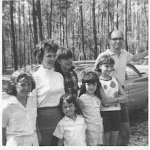This month was George Washington's 280th birthday, and I've learned recently that we are related to him on both sides of the family!
Our Wright ancestors (Haynie side) include
Anne Washington, great aunt of the father of our country, who married Major
Francis Wright in the 17th century, Westmoreland County, Virginia. Anne's father John Washington, great-grandfather of General George Washington, was the family member who acquired the land where Mount Vernon is located, south of Alexandria, Virginia. Lt. Col. John Washington (born circa 1632) served in the House of Burgesses for Westmoreland County, in the colonial capital of Jamestown; as did our ancestor Capt. John Haynie (b. circa 1624) of Northumberland County, just a few years earlier (1660s and 1650s, respectively). Their home counties are adjacent to each other along the Potomac River, with Northumberland County being situated closer to Chesapeake Bay.
Our Smith ancestors (Tillett side) include
Elizabeth Warner and her husband
John Lewis. Elizabeth was another of George Washington's great aunts, sister of his grandmother Mildred Warner. Mildred married Lawrence Washington, brother of the above Anne! (Mildred and Lawrence were the parents of Augustine Washington, who in turn - with his second wife Mary Ball - became the father of George.) The Warner-Lewis estate is called Warner Hall and is located in Gloucester County, Virginia.
So, all four of George Washington's paternal great-grandparents appear in our family tree:
John Washington,
Anne Pope (Washington),
Augustine Warner, and
Mildred Reade (Warner). Their graves have been preserved, in Westmoreland County and Gloucester County, respectively. The Washington burial site was incorporated into the George Washington Birthplace National Monument; while the graveyard at Warner Hall is maintained by the Association for the Preservation of Virginia Antiquities, or Preservation Virginia, as it's now called.
Elizabeth and Mildred Warner's father and their grandfather, both named Augustine Warner, served for many years in the colonial assembly and also on the royal Council. The elder Warner is said to have arrived in Virginia in 1628 at the age of seventeen. His son, having been educated in England, represented Gloucester County in the House of Burgesses and served as Speaker of the House in 1676 and 1677.
During Bacon's Rebellion (1676), which came about because of differences of opinion in how to handle conflicts with Indian tribes, Warner and other leaders of the Jamestown government temporarily evacuated the area. The rebel leader commandeered and looted the Warner home, for which Speaker Warner sought compensatory damages against William Byrd I, an associate of Bacon, as Nathaniel Bacon had suddenly died. The following year Warner was appointed to the King's Council, where he served until his rather premature death in 1681. The information concerning Warner's efforts to obtain compensation for damage to their home is found in the book
Speakers and Clerks of the Virginia House of Burgesses 1643-1776.
The image of Colonel Augustine Warner (born 1642), attached here with that of his great-grandson President Washington (b. 1732), is the earliest portrait we have, to date, of any of our American ancestors!
In addition to the kinship with George Washington, the Warner and Lewis families also connect us genetically to Meriwether Lewis (Corps of Discovery), General Robert E. Lee, and even Queen Elizabeth II.











